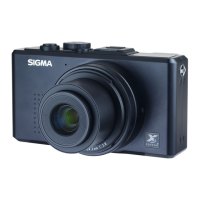A Lens that Produces an Astonishing Image
The DP2 and DP2s feature
an integral standard lens
A lens with a focal length of 40mm
to 60mm on a 35mm film camera is
known as a “standard lens” because it
delivers natural perspective, close to
what the human eye perceives.
The usual definition of a standard lens
is one that has a focal length close
to the diagonal length of the image
format. The focal length of the DP2's
and DP2s's lens is 24.2mm, and the
diagonal length of the image sensor is
24.86mm. So, the lens used in the DP2
and DP2s really does deserve to be
called a standard lens.
In the past, standard lenses have
traditionally been of either the Tessar
or the Gauss type. The Gauss type is
basically used for larger apertures with
high performance. Its disadvantages
include susceptibility to saggital
coma flare when used with a point
light source, and a tendency for the
light volume to decrease towards the
periphery. The Tessar type, on the other
hand, has a simple structure, making
it easy to miniaturize. However, its
drawback is that it tends not to deliver
high performance at larger apertures.
Adapting SLR lens technology
for our own purposes
Sigma believes that a photo is only
as good as the lens it was taken with.
So we decided that the kind of quality
we wanted for the DP2 and DP2s
would not be attainable using the
traditional techniques used to design
standard lenses. We rethought the
design from the development stage,
and set out in pursuit of the highest
possible lens performance. We took
the bold step of using a retrofocus
lens of the type mainly used as wide-
angle lenses for SLRs.
Besides having the excellent
telecentricity vital in lenses for digital
cameras, this retrofocus lens has
many other advantages: for example,
this format makes it easy to suppress
field curvature and astigmatism,
and to ensure that the light volume
stays the same right to the periphery.
However the lens does need to be
longer. Therefore, in order to minimize
the total length of the lens while still
attaining ideal image quality,
we used two groups of lens elements:
the group at the front have a high
refractive index, and the group at the
rear are aspherical glass-mold lenses.
This way, we successfully developed
a standard lens with a relatively
modest overall length, but very high
optical performance.
A super-high-performance lens that's
flat as a pancake right to the edge
In order to maintain high resolution
and contrast from the center of the
screen right to the edge, and to allow
scope for those cool background-
blur effects, we aimed for the kind of
MTF and all-round lens performance
only available with single-index lenses.
We are confident that the DP2's and
DP2s's lens, improved time and time
again in the interests of delivering
the best possible finished image,
encapsulates Sigma's expertise as a
leading manufacturer of lenses.
The impact of the eye-popping
image quality delivered by the DP2's
lens is something you really need to
see for yourself.
The DP2's and DP2s' s integral lens is of the
retrofocus type. Besides having the excellent
telecentricity vital in lenses for digital cameras,
this retrofocus lens has many other advantages:
for example, this format makes it easy to
suppress field curvature and astigmatism,
and to ensure that the light volume stays the
same right to the periphery. However the lens
does need to be longer. Therefore, in order
to minimize the total length of the lens while
still attaining ideal image quality, we used two
groups of lens elements: the group at the front
have a high refractive index, and the group at
the rear are aspherical glass-mold lenses.
This way, we successfully developed a standard
lens with a modest overall length, but very high
optical performance.
As well as employing a rear-focus system,
we used aspherical glass-mold lenses, enabling
aberration variation to be minimized.
And the elements that make up the DP2's and
DP2s's lens have been treated with a super-
multilayer coating that succeeds in keeping
ghosting and flare to a minimum.
That's not all. Some of the DP2's and DP2s's
lens elements are hyperchromatic, which
enables chromatic aberrations to be corrected
to a large extent, without impacting other
aberrations. This means that even with a wide-
open aperture, the images produced have
minimal color flare, and are nice and sharp and
crisp, right to the edge. The Foveon X3®, which
delivers amazing color resolution, also makes
a big contribution to the very high level of
“emotional image quality” delivered.
The construction of the special-design lens
Sigma Lens 24.2mm F2.8 / MTF Chart
10 lp
30 lp
Spatial Frequency Sagittal Line Meridional Line
The MTF chart gives the results at the wide-open aperture.
Glassmold Aspherical Lens
1
0.9
0.8
0.7
0.6
0.5
0.4
0.3
0.2
0.1
0
IMAGE HEIGHT (mm)
CONTRAST
0 2.5 5 7.5 10 12.43
18

